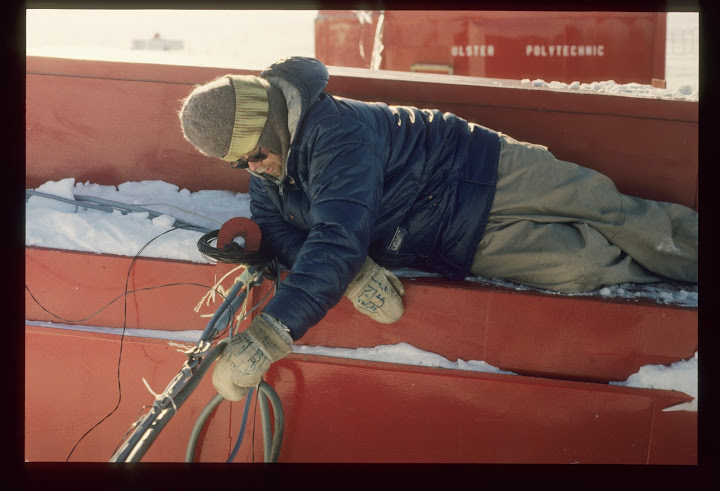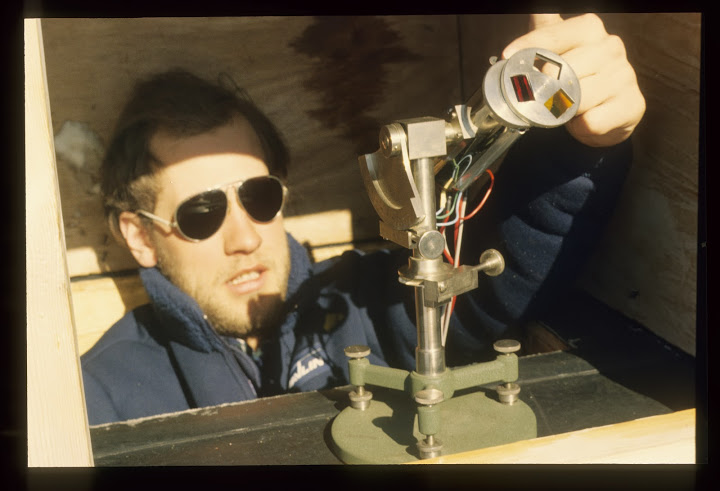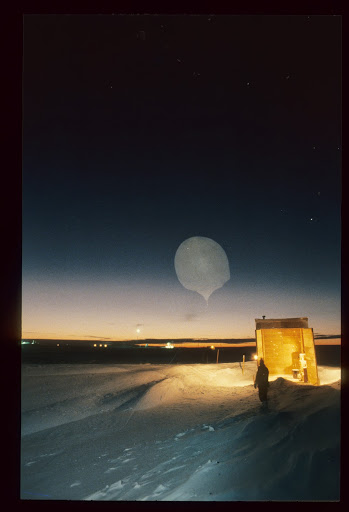|
 |
| . | Picture by Ian Jones |
|
Jules Rowse attaches the valve to a hydrogen cylinder during a balloon
launch. December 1982.
|
In previous years, the hydrogen to fill the met. balloons came from a
hydrogen generator. However that had been lost in a fire the previous
year, so during 1982 and 1983 we used cylinders of hydrogen to fill the
balloons. This limited us to 3 or 4 launches per week, instead of the
normal 7. A hydrogen generator did arrive at Halley in January 1984 as
part of the equipment for the new Halley 4 base.
 |
| . | Picture by Ian Jones |
|
Keith Wright disconnects cables from the caboose of the Advanced
Ionospheric Sounder (AIS) in preparation for raising it clear of the
snowdrifts which built up around it continuously.
|
The AIS was a computer-controlled radio transmitter and receivers, which
sent radio signals into the ionosphere and listened for the echoes. The
masts for the transmitter aerial were over 100 feet high.
 |
| . | Picture by Ian Jones |
|
My colleague Dave Try operates the Angstrom pyrheliometer, through a hatch
in the roof of the radiation hut. This measures the amount of dust and
aerosols in the atmosphere.
|
We would make these observations whenever we
had clear sunshine at local apparent noon. One of us would keep the
instrument pointed at the sun and operate the filters, while the other
inside the hut would note the time and the readings from the instrument.
 |
| . | Picture by Ian Jones |
|
Rudy Bramwell and Andy Hill riding in the Maudheim sledge behind a Snocat,
October 1982.
|
When there was not enough room for everyone inside the Snocat, the rest of
us rode on this sledge which was just an upturned wooden box mounted on
sledge runners. For the building of Halley 4 in the summer 1982-3, when
large numbers of people had to be ferried between the Bransfield and the
building site, more luxurious sledges were provided which had roofs and
padded benches inside. We could not understand the complaints of some
builders about their discomfort.
 |
| . | Picture by Ian Jones |
|
Launching a radiosonde balloon. June 1982.
|
We launched the balloons around 9:30am in the mornings, so that they would
cross the tropopause at 10:00am (12 noon GMT). In the winter we used
rubber balloons dipped in oil to soften the fabric, in the hope of
achieving greater altitude. The radiosonde attached to the balloon would
radio back atmospheric data for up to 90 minutes before the balloon burst,
at maybe 15km altitude, and crashed back to Earth.
I took this photo using a flash to capture the balloon, combined with a
time exposure of several seconds to register the sky, which explains the
ghostly appearance of the balloon and the people.
 |
| . | Picture by Ian Jones |
|
Dave Try operating the theodolite during a radiosonde flight. August 1982.
The theodolite is mounted in the top of one of the base's shafts,
affording just a little protection against the wind.
|
Normally we would have used a radar to track the balloon's ascent. However
vital parts of the radar had been destroyed in a fire the previous year,
so if the sky was clear we could track the balloon's progress with a
theodolite instead. Since a typical balloon flight lasted 90 minutes, this
was a perishing cold job. Colleagues in the nice warm met room down in the
base are calling out each minute over the headset, and Dave is reading
back the balloon's elevation and azimuth.
|